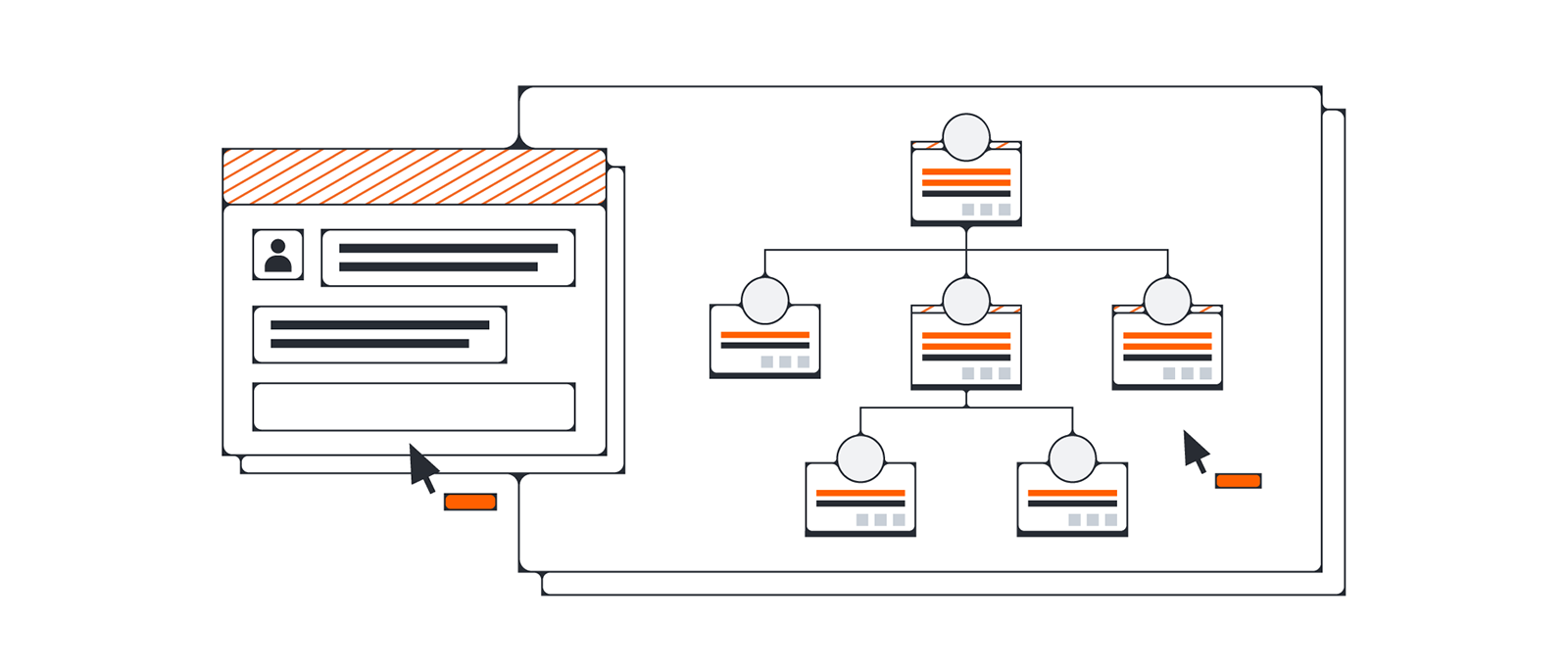
How to map accounts for account-based marketing
Lucid Content
Reading time: about 6 min
Sales and marketing teams are always working toward the same goal: connect prospective customers with a specific product or solution. However, these two departments aren’t often fully aligned. While they might connect over shared projects or resources, this lack of total alignment limits each team’s potential and the growth of the company at large.
One possible solution to this problem? Account-based marketing (ABM). By fully embracing an ABM methodology, companies have the opportunity to bridge the divide between sales and marketing. When demand generation programs are synced with defined accounts and sales goals, you can expect to see an impressive ROI.
An introduction to account-based marketing
A holistic sales and marketing strategy involves many efforts, from cold call sales outreach to robust content marketing programs that aim to attract and educate potential buyers. All of these efforts are valuable as part of your digital marketing strategy.
However, not all of the opportunities they generate are created equal and, frankly, not every lead is worthy of your team’s time and attention. Rather than investing time and attention on every opportunity that comes through the pipeline, ABM is a strategic approach that focuses marketing efforts on target accounts through personalized messaging that builds stronger client relationships and creates value for the customer at every stage of their lifecycle. Research shows that organizations measuring the impact of ABM see better engagement, improved win rates, larger deal size, and improved ROI across their targeted accounts.
Track deal progression and gain key executive sponsorship with <strong>account mapping</strong>.
Learn more6 steps to mapping accounts for account-based marketing
At its core, account-based marketing is just good marketing. Still, doing ABM right means identifying the high-value accounts that will give you the highest return on your marketing investment. Once you identify these accounts, account mapping can help you optimize the way you interact with and market to them.
Let’s take a look at how to incorporate account mapping into account-based marketing strategies.
1. Identify decision-makers
Building mutually beneficial relationships with the people at your target accounts is always a good strategy. However, finding champions and advocates for your brand or product is only half the battle. Along with your main points of contact, it’s important to identify the key stakeholders and decision-makers who will, ultimately, make the final buying decision and sign on the dotted line.
B2B buying groups are increasingly diverse and their involvement spans many different functions. It’s important to tailor your communication to the unique considerations and priorities of each type of decision-maker.
- Practitioner/Evaluator: Though they’re not the ultimate decision-makers, the day-to-day users of your product can strongly influence a buying decision. Make sure to demonstrate how your solution will help them do their jobs better and give them resources to advocate on your behalf.
- Budget Approver/Gatekeeper: For these decision-makers, it’s all about ROI. Focusing on results can help loosen the purse strings.
- Decision-Maker/Buyer: Understanding the goals and priorities of the ultimate decision-makers and buyers will help you tailor your messaging to address their specific concerns and needs.
- Procurement: A different kind of gatekeeper, procurement is tasked with ensuring partners are delivering on terms of service and, ultimately, ROI. Building trust and open paths of communication with procurement teams can help you fast track the buying process.
2. Create an account map
When sales and marketing combine their expertise, ABM can be beneficial. Creating a robust account map can help you quickly identify each type of decision-maker at your target organization and where they sit in the decision-making process.
Account maps give sales and marketing the visual representation they need to collaborate on strategic ABM efforts. Sales leaders can identify opportunities for additional coaching, marketing leaders can identify gaps in messaging, and both teams can quickly see any key relationships that may have been missed. Account mapping features in Lucidchart can help sales and marketing teams collaborate around key accounts in real time to land more deals, grow accounts quickly, minimize client churn, and visualize the best path to win.
3. Identify customer pain points
The only way to create relevant, personalized messaging is to understand where people are coming from. What keeps your customers and prospects up at night? How is their success being measured? Where do they feel the most pain day-to-day, and how can your product or solution directly address those pain points?
This step also requires cross-functional collaboration across the organization. Sales teams can communicate top pain points shared with them by prospects and customers to help both marketing and sales fine-tune the messaging and selling points that drive the most results and engagement. Once the customer relationship is established, customer success teams can report back to sales and marketing on any sticking points or ongoing frustrations to help optimize future ABM engagements and improve retention.
4. Identify best communication channels
To build an effective ABM strategy, it’s essential to understand the most effective communication channel for each point of contact. For example, busy day-to-day users may not have time to engage on social channels, but they might respond to a strategically crafted email.
Meanwhile, executives may spend more time networking and engaging with content on LinkedIn. Meet your customers and prospects where they are, and track those channel preferences in your account map to guide future communication.
5. Develop messaging
Once you’ve identified key accounts and decision-makers, their pain points, and the optimal channels of communication for each of them, it’s time to tailor and personalize your outreach and messaging.
- In-person or virtual events: Invite key points of contact to an event and encourage them to invite their colleagues to expand awareness across the target account.
- Podcasts: Similarly, consider inviting a leader from a target account to join your company on a webinar or podcast.
- Direct mail: Amid digital content and email overload, direct mail can make you stand out from the crowd. Send a personalized package to key decision-makers at your target accounts and follow up with personalized outreach on digital channels.
Website personalization is an effective tactic in any ABM strategy. Tools like Sitecore can help you identify and match visitors from target accounts to surface personalized web experience through custom hero images, targeted landing pages, and even navigation options that directly speak to their industry.
Your account map can provide ongoing insight into the overarching messages that resonate with decision-makers across your target accounts.
6. Return to your account map frequently
While the data shows that ABM works, that doesn’t mean it’s easy. Effective ABM requires a complete shift in mindset from traditional sales and marketing handoffs to a more cross-functional, collaborative, and disciplined approach.
Encourage your sales and marketing teams to continuously add new data, relevant information about key decision-makers and conversations, and other learnings to keep your account map as up-to-date and strategically beneficial as possible. Then, return to your account map frequently to keep teams rooted in process and focused on the tactics that will drive the most results.

Turn account maps into valuable sales tools with <strong>Lucidchart</strong>.
Learn moreAbout Lucidchart
Lucidchart, a cloud-based intelligent diagramming application, is a core component of Lucid Software's Visual Collaboration Suite. This intuitive, cloud-based solution empowers teams to collaborate in real-time to build flowcharts, mockups, UML diagrams, customer journey maps, and more. Lucidchart propels teams forward to build the future faster. Lucid is proud to serve top businesses around the world, including customers such as Google, GE, and NBC Universal, and 99% of the Fortune 500. Lucid partners with industry leaders, including Google, Atlassian, and Microsoft. Since its founding, Lucid has received numerous awards for its products, business, and workplace culture. For more information, visit lucidchart.com.
